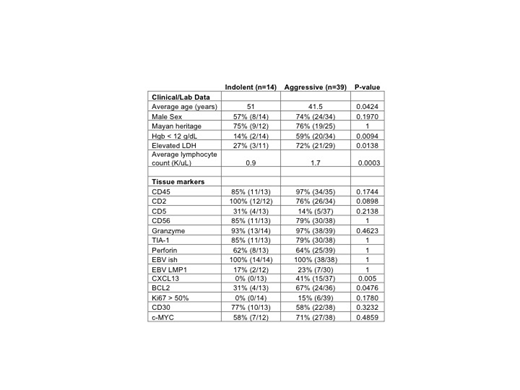Introduction
Extranodal NK/T-cell lymphoma, nasal type (ENKTL), is the most frequent NK-cell malignancy. It is typically associated with a highly aggressive course and extensive local tissue destruction. ENKTL, nasal type, is most common among East Asians and indigenous persons in Latin America, which may result from genetic predisposition, shared strains of EBV infection or other factors. We noted that a subset of patients with ENKTL in Guatemala present with more indolent disease. The clinical and histologic features of these indolent cases, including outcomes after treatment, have not been defined.
Methods
We reviewed clinical data from 68 patients with ENKTL at INCAN, the largest public cancer hospital in Guatemala, who underwent evaluation between 2006-2018. We confirmed the diagnosis of ENKTL using available paraffin-embedded biopsies based on immunohistochemistry and in situ hybridization for 46 markers at Stanford University (O.S., Y.N.). We defined indolent cases as those lacking macroscopic necrosis, palate perforation, distant lesions (i.e. Stage II or greater), hemophagocytic lymphohistiocytosis (HLH) and B symptoms. Aggressive cases had one or more of these characteristics. Statistical analysis on categorical data was performed using Fisher's exact test.
Results
Fifty-three patients were confirmed to have ENKTL. The median age at the time of diagnosis was 43 years (range: 11-83) and 36 patients were male (68%). 75.7% of patients self-identified as Mayan ancestry and 85% were born or lived in central or western Guatemala.
As outlined in the Table, 14 cases were classified as indolent and 39 were aggressive. Patients with indolent NKTCL were older (mean, 51 years vs. 41.5 years in the aggressive group; p=0.04). Patients with aggressive disease more commonly had anemia, lymphocytopenia and elevated serum LDH. Both indolent and aggressive cases typically had NK cell immunophenotype, including positivity for CD56, granzyme, perforin and TIA-1. All 53 NKTCLs expressed EBER, consistent with EBV infection, with a subset in each group also expressing EBV LMP1. In contrast, greater than 40% of aggressive cases expressed CXCL13 compared to 0% of indolent cases (p=0.005). Aggressive cases were more commonly BCL2 positive (67% versus 31%, p = 0.048). A subset of aggressive cases had Ki67 >50% (6/39 versus 0/14 indolent cases) but there were also aggressive cases with Ki67 <10%. A multiple correspondence analysis using 14 clinical and 18 IHC markers was performed on 33 patients with complete data available. Variables contributing to categorization of aggressive versus indolent ENKTL included palate perforation, peripheral blood lymphocyte count < 0.8 K/uL, B symptoms, anemia, cachexia and macroscopic necrosis.
Median survival was markedly better for patients with indolent disease compared to those with aggressive disease (median not reached vs. 2 years, p<0.05). Twelve of (92.9%) thirteen treated patients in the indolent group achieved a complete response compared to only 8 (40%) of 22 treated for aggressive disease (p=0.04). In fact, 9 patients with aggressive disease died before receiving treatment compared to 0 with indolent disease (23.0% vs. 0%; p=0.04). Three of the deaths in patients with indolent disease were due to toxicity from chemotherapy (infection, pancytopenia).
Conclusion
Approximately one-quarter of patients with extranodal NK/T cell lymphoma, nasal type, in our cohort have a unique variant associated with the absence of aggressive clinical features. These patients have a more indolent clinical course, better outcome with treatment, have less frequent expression of BCL2, and lack CXCL13 expression. Patients with the indolent variant may benefit from less aggressive therapeutic approaches to minimize unnecessary treatment-associated toxicity. Efforts to define genetic and transcriptional characteristics of these cases are underway.
Weinstock:Celgene: Research Funding.
Author notes
Asterisk with author names denotes non-ASH members.


